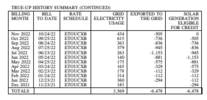I recently received my first NEM2 true-up. It seems to be following a rule different from those described in NEM-PS Annual True-Up Calculation [PG&E example]
I'm putting this in a new thread so as not to confuse the excellent explanation it the post linked above. If my true-up implies changes are needed in that post, the time to do that would be after this one is sorted out.
I have ferreted out the calculation that was done in my true-up, so I do understand the arithmetic. What I would like some help on is fiuguing out if this different rule makes sense.
Here is the information from my B&W True-Up statement, following the format in the post above:
Minimum Charges – ($10.90)
NEM True-Up Adjustment – ($67.43)
Energy Commission Tax – ($.83)
Electric Utility User Tax - ($5.87) (I think this is a county tax)
Total Current Month's Electric Charges Due – ($85.03)
(Don't get me wrong, this low amount is better than I had hoped!)
Cumulative Energy Charges or Credits – ($356.87)
Cumulative Non-Bypassable Charges – ($191.49)
Previous Billed Amounts – ($124.06)
So, this would seem to match Case 1 in aesculus post.
Case 1 - Cumulative Total Charges or Credits ($356.87) is greater or equal to the Cumulative Non-Bypassable Charges ($191.49): This is true in my case. Now I'll substitute my numbers in the posted calculation:
In this case you pay the Cumulative Total Charges or Credits ($356.87) minus the Previous Billed Amount ($124.06) plus the unpaid Minimum Charges ($10.90) from the current month which equals $243.71. Now since PG&E likes to make things confusing to the reader, they split out the Energy Commission Tax of $.83 (and my Utility Tax of $5.87) from Cumulative Total Charges or Credits which gets you the numbers in the first table.
The difference lies in the NEM True-Up adjustment. Where the post used the Cumulative Total Charges or Credits (which makes complete sense), on mine PG&E instead used the the lower Cumulative Non-Bypassable Charges – ($191.49). This minus the Previously Billed Amounts ($124.06) equals $67.43 for the NEM True-Up Adjustment, and hence the $$85.02 total due:
OK, so that is PG&E's explanation of "why" they did this, but I don't see the logic behind this.
I see a phrase in the NEM2 tariff (S.C.2,h) which says that if the net generation charges are less than zero, the credit will not be applied. That might explain it, but in my case , the generation charges exceeded the credits by $247.91, so this would not seem to apply.
Any ideas?
Thanks!
SW
I'm putting this in a new thread so as not to confuse the excellent explanation it the post linked above. If my true-up implies changes are needed in that post, the time to do that would be after this one is sorted out.
I have ferreted out the calculation that was done in my true-up, so I do understand the arithmetic. What I would like some help on is fiuguing out if this different rule makes sense.
Here is the information from my B&W True-Up statement, following the format in the post above:
Minimum Charges – ($10.90)
NEM True-Up Adjustment – ($67.43)
Energy Commission Tax – ($.83)
Electric Utility User Tax - ($5.87) (I think this is a county tax)
Total Current Month's Electric Charges Due – ($85.03)
(Don't get me wrong, this low amount is better than I had hoped!)
Cumulative Energy Charges or Credits – ($356.87)
Cumulative Non-Bypassable Charges – ($191.49)
Previous Billed Amounts – ($124.06)
So, this would seem to match Case 1 in aesculus post.
Case 1 - Cumulative Total Charges or Credits ($356.87) is greater or equal to the Cumulative Non-Bypassable Charges ($191.49): This is true in my case. Now I'll substitute my numbers in the posted calculation:
In this case you pay the Cumulative Total Charges or Credits ($356.87) minus the Previous Billed Amount ($124.06) plus the unpaid Minimum Charges ($10.90) from the current month which equals $243.71. Now since PG&E likes to make things confusing to the reader, they split out the Energy Commission Tax of $.83 (and my Utility Tax of $5.87) from Cumulative Total Charges or Credits which gets you the numbers in the first table.
- Minimum Charges – ($10.90)
- NEM True-Up Adjustment – ($231.98) = ($356.87 - $.83 - $124.06)
- Energy Commission Tax – ($.83)
- Utility Tax - ($5.87)
- Total Current Month's Electric Charges Due – ($243.71) = ($10.90 + $231.98 + $.83 + $ 5.87)
The difference lies in the NEM True-Up adjustment. Where the post used the Cumulative Total Charges or Credits (which makes complete sense), on mine PG&E instead used the the lower Cumulative Non-Bypassable Charges – ($191.49). This minus the Previously Billed Amounts ($124.06) equals $67.43 for the NEM True-Up Adjustment, and hence the $$85.02 total due:
- Minimum Charges – ($10.90)
- NEM True-Up Adjustment – ($67.43) = ($191.49 - $124.06)
- Energy Commission Tax – ($.83)
- Utility Tax - ($5.87)
- Total Current Month's Electric Charges Due – ($85.03) = ($10.90 + $67.43 + $.83 + $ 5.87)
OK, so that is PG&E's explanation of "why" they did this, but I don't see the logic behind this.
I see a phrase in the NEM2 tariff (S.C.2,h) which says that if the net generation charges are less than zero, the credit will not be applied. That might explain it, but in my case , the generation charges exceeded the credits by $247.91, so this would not seem to apply.
Any ideas?
Thanks!
SW



